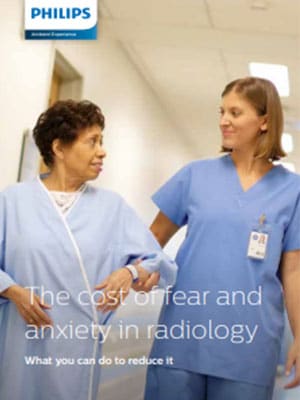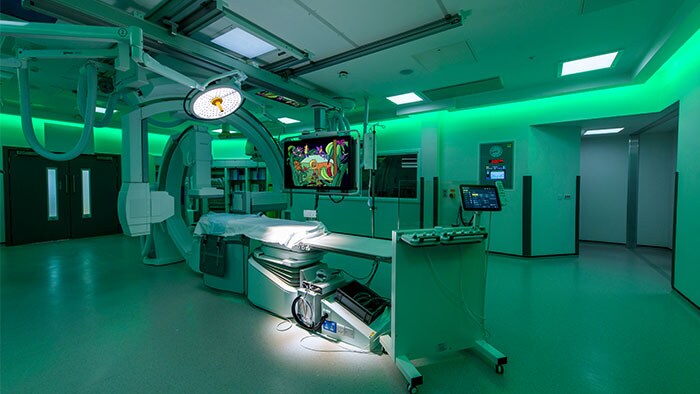Improving the experience:
Strategies for patient satisfaction
How to create a calming and engaging experience
Feelings of anxiety and apprehension are common among patients who must undergo a diagnostic exam or therapeutic intervention. Whether it be an MRI or CT exam, or a percutaneous coronary intervention (PCI), better patient cooperation in imaging can be achieved by creating an engaging, welcoming, and multi-sensorial patient experience. Philips Ambient Experience solutions can help create a calming environment to support efficient patient care and enhanced staff satisfaction. Integrated dynamic lighting, video, and audio components help to soothe the anxious patient – enhancing the patient experience and satisfaction, thereby supporting improved compliance. This solution is applicable across your diagnostic imaging rooms, such as CT, MRI, radiography, as well as interventional rooms.
Experiencing a friendly MRI environment - Lahey Health implemented Ambient Experience solutions to help create a calming patient experience.
We’ve gotten nothing but great feedback from the patients and their families about Ambient Experience. It’s been such a lovely environment for everyone to work in.''
Mary Boff, ARRT (NM) (CT)
Lead Technologist, Molecular Imaging, Phoenix Children’s Hospital
The patient imaging experience – case studies
Helping to reduce patient stress to improve MR imaging at Lahey Hospital
Creating a calming and engaging X-ray environment for Children’s Alabama
Putting people at the heart of diagnostic procedures at Miami Cardiac and Vascular Institute
Want to connect with us? Complete the form below and we will follow-up.
Setting the stage for a new patient experience
A care environment perceived as cold, brightly lit, cluttered, and unwelcoming, can negatively impact the overall patient experience. Yet a well-thought-out hospital environment can lead to physical and emotional comfort. Philips looks beyond the medical equipment to address the tenor of the space itself.
What can be done?

The cost of fear and anxiety in radiology
In this paper, Philips provides research findings and shares strategies on how to reduce negative feelings and their impact on your radiology examinations and operations.
Additional benefits to patients and staff
Never before have I gotten so many comments from our patients, saying wow that was a really good experience – this is much different than any other MR experience that I’ve had elsewhere.''
Constantino Pena, MD
Medical Director of Vascular Imaging at Baptist Hospital

Anxiety
Patients can personalize the multisensorial room environment by selecting from a list of comforting, relaxing room themes for personal audio and video content. Providing the opportunity to choose a room theme gives patients a sense of control.

Sedation
When the patient is relaxed this leads to smoother procedures, reduces the number of rescans, and can even diminish the need for sedation.1 A reduction in sedation has obvious benefits, particularly with pediatric and geriatric patients.

Care
With a relaxed patient comes increased cooperation and compliance – a patient who is more likely to remain still during the procedure. A patient more likely to follow instructions may also lead to higher staff productivity.

Design strategies
Their experience becomes interactive, soothing, and less intimidating. Design strategies such as clear sightlines, recessed cabinetry, and privacy glass also help lessen the patient’s sense of isolation and decreases stress.

Why focus on the care environment?
Philips understands that many of the issues which impact patients and staff may also have a direct impact on the quality of care. Patients face a fear of the unknown and a perceived threat to their wellbeing. Staff may struggle with lack of patient cooperation and extra time required for rescans.
A cross-modality patient experience solution

MRI

CT

Interventional Suite

Radiography

The concept of creating an atmosphere of ‘positive distraction’ that engages the patient and reduces anxiety has proven to be successful. With a talented group of experts in lighting design, spatial design, and multimedia design, Philips has transformed the imaging experience.
Over 2500 installations demonstrate its efficacy.
Ambient Experience for pediatrics
Captivating characters engage children and create a positive imaging experience.
Improving staff workflow
As an immersive solution, Ambient Experience helps to positively impact the staff workflow and productivity.
1Delewi R., et al. Anxiety levels of patients undergoing coronary procedures in the catheterization laboratory. International Journal of Cardiology. 2017; 228:926-930. doi:10.1016/j.ijcard.2016.11.043


